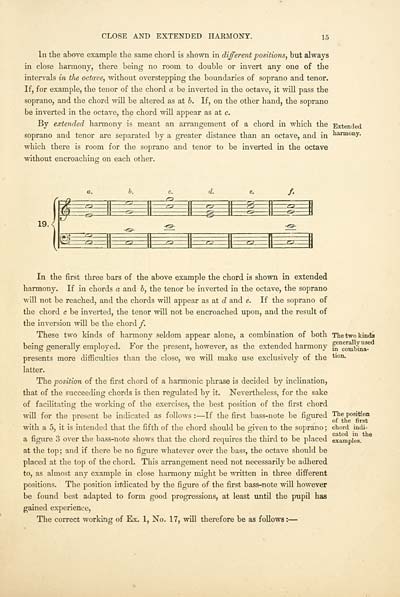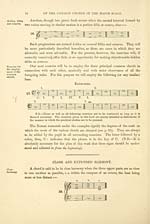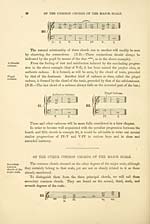Inglis Collection of printed music > Printed text > Treatise on harmony
(23) Page 15
Download files
Complete book:
Individual page:
Thumbnail gallery: Grid view | List view

CLOSE AND EXTENDED HARMONY.
15
In the above example the same chord is shown in different positions, but always
in close harmony, there being no room to double or invert any one of the
intervals in the octave, without overstepping the boundaries of soprano and tenor.
If, for example, the tenor of the chord a be inverted in the octave, it will pass the
soprano, and the chord will be altered as at b. If, on the other hand, the soprano
be inverted in the octave, the chord will appear as at c.
By extended harmony is meant an arrangement of a chord in which the Extended
soprano and tenor are separated by a greater distance than an octave, and in harmony,
which there is room for the soprano and tenor to be inverted in the octave
without encroaching on each other.
i
-7rr
c.
3E
19.
ZZ3Z
32=
=S2=
In the first three bars of the above example the chord is shown in extended
harmony. If in chords a and b, the tenor be inverted in the octave, the soprano
will not be reached, and the chords will appear as at d and e. If the soprano of
the chord c be inverted, the tenor will not be encroached upon, and the result of
the inversion will be the chord /.
These two kinds of harmony seldom appear alone, a combination of both
being generally employed. For the present, however, as the extended harmony
presents more difficulties than the close, we will make use exclusively of the
latter.
The position of the first chord of a harmonic phrase is decided by inclination,
that of the succeeding chords is then regulated by it. Nevertheless, for the sake
of facilitating the working of the exercises, the best position of the first chord
will for the present be indicated as follows : — If the first bass-note be figured
with a 5, it is intended that the fifth of the chord should be given to the soprano ;
a figure 3 over the bass-note shows that the chord requires the third to be placed
at the top; and if there be no figure whatever over the bass, the octave should be
placed at the top of the chord. This arrangement need not necessarily be adhered
to, as almost any example in close harmony might be written in three different
positions. The position irfdicated by the figure of the first bass-note will however
be found best adapted to form good progressions, at least until the pupil has
gained experience,
The correct working of Ex. 1, No. 17, will therefore be as follows: —
The two kinds
generally used
in combina-
tion.
The position
of the first
chord indi-
cated in the
examples.
15
In the above example the same chord is shown in different positions, but always
in close harmony, there being no room to double or invert any one of the
intervals in the octave, without overstepping the boundaries of soprano and tenor.
If, for example, the tenor of the chord a be inverted in the octave, it will pass the
soprano, and the chord will be altered as at b. If, on the other hand, the soprano
be inverted in the octave, the chord will appear as at c.
By extended harmony is meant an arrangement of a chord in which the Extended
soprano and tenor are separated by a greater distance than an octave, and in harmony,
which there is room for the soprano and tenor to be inverted in the octave
without encroaching on each other.
i
-7rr
c.
3E
19.
ZZ3Z
32=
=S2=
In the first three bars of the above example the chord is shown in extended
harmony. If in chords a and b, the tenor be inverted in the octave, the soprano
will not be reached, and the chords will appear as at d and e. If the soprano of
the chord c be inverted, the tenor will not be encroached upon, and the result of
the inversion will be the chord /.
These two kinds of harmony seldom appear alone, a combination of both
being generally employed. For the present, however, as the extended harmony
presents more difficulties than the close, we will make use exclusively of the
latter.
The position of the first chord of a harmonic phrase is decided by inclination,
that of the succeeding chords is then regulated by it. Nevertheless, for the sake
of facilitating the working of the exercises, the best position of the first chord
will for the present be indicated as follows : — If the first bass-note be figured
with a 5, it is intended that the fifth of the chord should be given to the soprano ;
a figure 3 over the bass-note shows that the chord requires the third to be placed
at the top; and if there be no figure whatever over the bass, the octave should be
placed at the top of the chord. This arrangement need not necessarily be adhered
to, as almost any example in close harmony might be written in three different
positions. The position irfdicated by the figure of the first bass-note will however
be found best adapted to form good progressions, at least until the pupil has
gained experience,
The correct working of Ex. 1, No. 17, will therefore be as follows: —
The two kinds
generally used
in combina-
tion.
The position
of the first
chord indi-
cated in the
examples.
Set display mode to: Large image | Transcription
Images and transcriptions on this page, including medium image downloads, may be used under the Creative Commons Attribution 4.0 International Licence unless otherwise stated. ![]()
| Special collections of printed music > Inglis Collection of printed music > Printed text > Treatise on harmony > (23) Page 15 |
|---|
| Permanent URL | https://digital.nls.uk/94714364 |
|---|
| Description | Scottish and English songs, military music and keyboard music of the 18th and 19th centuries. These items are from the collection of Alexander Wood Inglis of Glencorse (1854 to 1929). Also includes a few manuscripts, some treatises and other books on the subject. |
|---|
| Description | The Glen Collection and the Inglis Collection represent mainly 18th and 19th century Scottish music, including Scottish songs. The collections of Berlioz and Verdi collected by bibliographer Cecil Hopkinson contain contemporary and later editions of the works of the two composers Berlioz and Verdi. |
|---|

